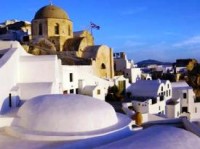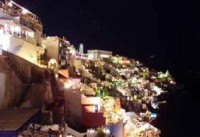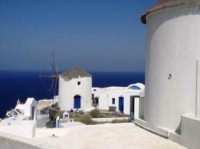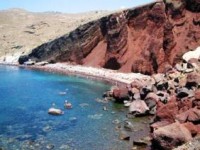Hundreds of islands dot the Aegean Sea, and who wouldn’t love to visit them all? But time-wary travelers have to choose, so we chose Santorini, Mykonos, and Naxos in the spring, when the air is fresh but warm and we could avoid high-season crowds and prices.
 John and I sailed to Santorini (also called Thira) on the catamaran FlyingCat4, not as atmospheric as taking the ferry, but a lot faster. We picked up a rental car at the dock, from a fellow with an “office” consisting of a card table.
John and I sailed to Santorini (also called Thira) on the catamaran FlyingCat4, not as atmospheric as taking the ferry, but a lot faster. We picked up a rental car at the dock, from a fellow with an “office” consisting of a card table.
The wide views from Santorini’s steep, stony cliffs are spectacular. The 33-square-mile island is the remnant of a volcano that erupted about 1500 BCE on a scale hard to imagine. The core blew sky-high, and the sea rushed into the crater to create a 1200-foot-deep bay. The intensely blue water is surrounded with huge cliffs topped by picturesque, snow-white villages — postcard scenes.
 Santorini has ancient ruins, gorgeous beaches, quaint houses, and friendly people. Did I mention the knock-your-socks-off views? From Fira, the clifftop main town, we gazed down on the caldera and a vast seascape with lava islets. However, after admiring the vista and folk museum, with its interesting displays of life in a village of the past, we moved on; Fira had too many tour groups for our taste. Oia offered charm and quiet. Our simple blue and white room in Delfini Apartments, with a terrace overlooking the caldera, was perfect. (But if we wanted a luxurious, honeymoon-perfect hotel, we’d go to the Mystique, a stunning resort.)
Santorini has ancient ruins, gorgeous beaches, quaint houses, and friendly people. Did I mention the knock-your-socks-off views? From Fira, the clifftop main town, we gazed down on the caldera and a vast seascape with lava islets. However, after admiring the vista and folk museum, with its interesting displays of life in a village of the past, we moved on; Fira had too many tour groups for our taste. Oia offered charm and quiet. Our simple blue and white room in Delfini Apartments, with a terrace overlooking the caldera, was perfect. (But if we wanted a luxurious, honeymoon-perfect hotel, we’d go to the Mystique, a stunning resort.)
 Oia’s main, traffic-free street runs along the rim, lined by numerous shops selling gorgeous jewelry and souvenirs. Wide stairs descend steeply to a small bay; or you can ride a donkey down and back. Our favorite spot to eat was the terrace at Skala, where we liked the octopus cooked with laurel leaves and the pine-nut pastry. For a change we went to the higher- priced Ambrosia and Nectar restaurant and ordered perfectly prepared chicken with ginger and almonds. Another time we’ll try 1800, in a restored sea captain’s mansion. It’s known for Mediterranean cuisine and a romantic atmosphere. Island specialties include rabbit with onions and cheese, garlicky pastries, vegetable fritters, and fruity white wines. Everywhere, we loved the grilled seafood and wonderful chocolate.
Oia’s main, traffic-free street runs along the rim, lined by numerous shops selling gorgeous jewelry and souvenirs. Wide stairs descend steeply to a small bay; or you can ride a donkey down and back. Our favorite spot to eat was the terrace at Skala, where we liked the octopus cooked with laurel leaves and the pine-nut pastry. For a change we went to the higher- priced Ambrosia and Nectar restaurant and ordered perfectly prepared chicken with ginger and almonds. Another time we’ll try 1800, in a restored sea captain’s mansion. It’s known for Mediterranean cuisine and a romantic atmosphere. Island specialties include rabbit with onions and cheese, garlicky pastries, vegetable fritters, and fruity white wines. Everywhere, we loved the grilled seafood and wonderful chocolate.
Akrotiri was a disappointment. This important Bronze Age archeological site, a town smothered 3600 years ago by tons of volcanic ash, is closed while its protective roof is under construction, and not scheduled to open any time soon. We consoled ourselves with a stop at Boutari Winery to taste island-made wines. Santorini’s volcanic soil, heat, and night humidity create good conditions for 36 varieties of grapes. The vines are twisted into basket shapes, and the grapes grow inside, protected from the wind.
We did see the ruins of Ancient Thira, on the east coast. To reach them, we drove up an incredibly precipitous, narrow, winding cobblestone road. It was worth it to get to the maze of stone walls defining millennia-old homes, shops and temples, and to see the sweeping view. No shade, though, and we agreed we should have brought our hats.
 Santorini’s beaches are famous for their colored sand: black, red, gold, white. One of the best is Perissa, next to Emporio village. The sand is smooth, the water crystal, and it’s protected from summer winds. Very popular Red Beach, near Akrotiri, has a dramatic setting, next to red lava cliffs. It’s reached by boat or a 10-minute walk from Akrotiri. Kamari is another favorite, and often crowded. As much as we loved Santorini, we were ready to move on and explore Naxos and Mykonos.
Santorini’s beaches are famous for their colored sand: black, red, gold, white. One of the best is Perissa, next to Emporio village. The sand is smooth, the water crystal, and it’s protected from summer winds. Very popular Red Beach, near Akrotiri, has a dramatic setting, next to red lava cliffs. It’s reached by boat or a 10-minute walk from Akrotiri. Kamari is another favorite, and often crowded. As much as we loved Santorini, we were ready to move on and explore Naxos and Mykonos.


Comments